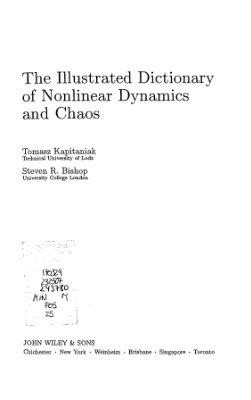John Wiley & Sons, 1999. - 267 pages.
The study of nonlinear dynamics is one of the most active fields in mode science. It reaches across the whole range of scientific study, and is applied in fields as diverse as physics, engineering, biology, economics and medicine. However, the mathematical language used to describe nonlinear dynamics, and the proliferation of new terminology, can make the use of nonlinear dynamics a daunting task to the non-specialist. In addition,the simultaneous growth in the use of nonlinear dynamics across different fields, and the cross-fertilization of ideas from different disciplines, mean that names and methods used and developed in one field may be altered when 're-discovered' in a different context, making understanding the literature a difficult and time-consuming task. The Illustrated Dictionary of Nonlinear Dynamics and Chaos addresses these problems.
The study of nonlinear dynamics is one of the most active fields in mode science. It reaches across the whole range of scientific study, and is applied in fields as diverse as physics, engineering, biology, economics and medicine. However, the mathematical language used to describe nonlinear dynamics, and the proliferation of new terminology, can make the use of nonlinear dynamics a daunting task to the non-specialist. In addition,the simultaneous growth in the use of nonlinear dynamics across different fields, and the cross-fertilization of ideas from different disciplines, mean that names and methods used and developed in one field may be altered when 're-discovered' in a different context, making understanding the literature a difficult and time-consuming task. The Illustrated Dictionary of Nonlinear Dynamics and Chaos addresses these problems.

